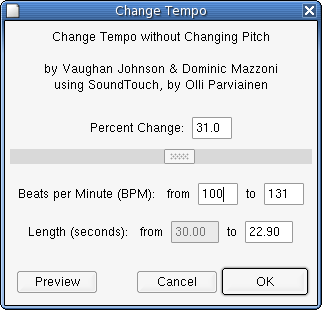
#FFMPEGX MUX AUDACITY TEMPO MOVIE#
Play several stretches of movie audio, and note the value in the dB meter when you do so (here, the value was around -10dB for loud sections, -12dB for quiet).Export the RiffTrax audio on its own, as a synced track.Silence each selection with Generate->Silence while the line is selected.Using the README file, locate and select each Disembaudio line.To correct for noticeable drift, you can delete or insert short periods of silence at the earliest noticeable drift point, to keep the audio in sync. It can be useful to test the first and last couple of Disembaudio lines, to see if there's any drift during the track. Select the zero point at the start of the RifftraxĪdd 9.083s of silence at the beginning of the RiffTrax audio using Generate->SilenceĬheck manually that the audio matches.

Now we can calculate an initial offset for syncing the tracks: 2:05.125 - 1:56.042 = 9.083s. Solo the movie audio, and identify the line in the movie - here it is at 2:05.125 Here, this is at 1:56.042 (after trimming, it tends to be slightly earlier than the movie time) Using the RiffTrax README (here Gravity_RiffTraxReadme.txt) locate the first Disembaudio line rifftrax_intro.wav), if you want to preserve it. optionally: create a new track ( Tracks->Add New->Mono Track) and paste in the audio you cut, then export the selected audio to a new file (e.g.Set the Selection Start manually to zero and cut the section.Locate the "and we're back" phrase in the RiffTrax audio, and place the cursor just ahead of that phrase (here, it's at 2:13.171).It can be useful to solo the RiffTrax audio for this stage.From this point on, the RiffTrax README file for the movie is very useful, and it's handy to have it open in a text editor window.Make sure that the RiffTrax commentary is the lower of the audio tracks - this is important for ducking, later.import RiffTrax audio to the Audacity project Eventually I settled on a 7:1 ratio as the initial dialogue is so quiet.ħ. The image shown is a first pass at compression.To even up the loud and quiet parts of the movie track, we use compression. Open Audacity (this will create a new project).create new Audacity project with movie audio The command above also converts the input audio to two channels (stereo). On the Mac, this can be done in homebrew using Since version 2.0, homebrew no longer allows installation/compilation options for core packages, so this needs to be installed from a third-party tap. ffmpegįor these instructions, ffmpeg needs to be built with the Fraunhofer AAC codec libfdk_aac. I'll be using the movie Gravity as an example, but you should change filenames, accordingly.Īs the focus of RiffTrax is really the jokes, we take some liberties with the movie audio - compressing the loud and quiet sections, and mixing down from surround/5.1 to stereo.

#FFMPEGX MUX AUDACITY TEMPO INSTALL#

Handbrake - to rip the video from the original media source (if necessary).ffmpeg - for audio extraction and final construction of the video (installable with brew).identify and extract audio track from the video Syncing RiffTrax to Ripped Video (Mac) Table of Contents


 0 kommentar(er)
0 kommentar(er)
